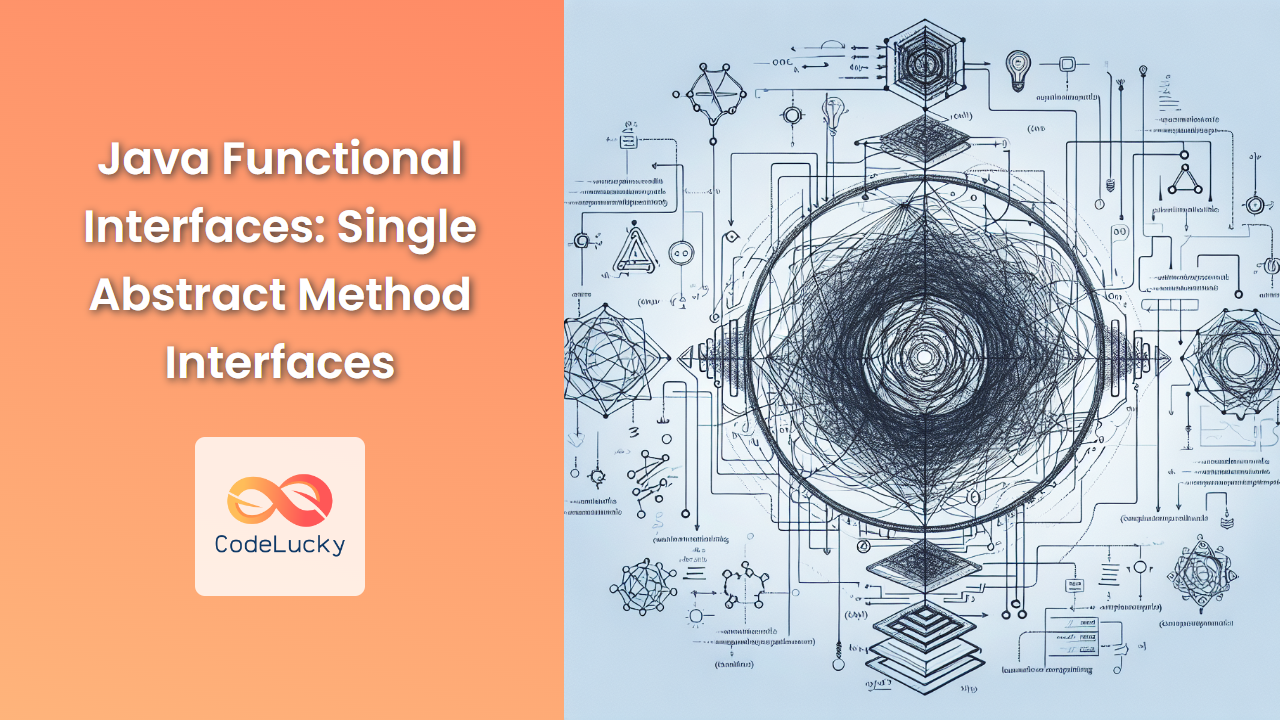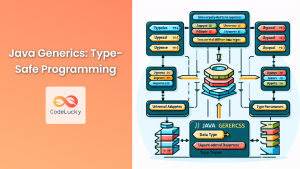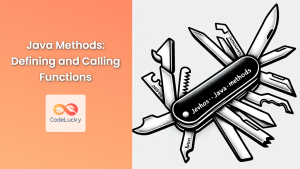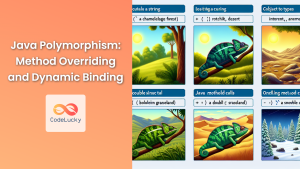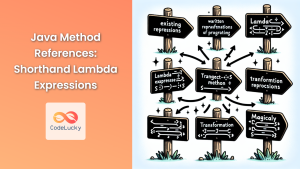Java 8 introduced a revolutionary concept that transformed the way developers write and structure their code: functional interfaces. These interfaces, also known as Single Abstract Method (SAM) interfaces, have become a cornerstone of modern Java programming, enabling more concise and expressive code. In this comprehensive guide, we'll dive deep into the world of functional interfaces, exploring their definition, benefits, and practical applications.
What are Functional Interfaces?
🔑 A functional interface is an interface that contains exactly one abstract method. These interfaces serve as the foundation for lambda expressions and method references in Java, allowing for more functional programming paradigms within the object-oriented structure of Java.
The key characteristics of a functional interface are:
- It has exactly one abstract method.
- It may contain default and static methods.
- It's annotated with
@FunctionalInterface(optional but recommended).
Let's look at a simple example of a functional interface:
@FunctionalInterface
public interface Greeting {
void greet(String name);
}
In this example, Greeting is a functional interface with a single abstract method greet().
The @FunctionalInterface Annotation
While not mandatory, the @FunctionalInterface annotation is a best practice when defining functional interfaces. It serves two primary purposes:
- It clearly communicates the intent that the interface should be used as a functional interface.
- It causes the compiler to generate an error if the interface does not meet the requirements of a functional interface.
For instance, if we try to add another abstract method to our Greeting interface:
@FunctionalInterface
public interface Greeting {
void greet(String name);
void farewell(String name); // Compiler error!
}
This would result in a compiler error, as functional interfaces must have exactly one abstract method.
Built-in Functional Interfaces
Java provides a rich set of built-in functional interfaces in the java.util.function package. These cover a wide range of common use cases, reducing the need to create custom functional interfaces in many scenarios. Let's explore some of the most frequently used ones:
1. Function
The Function interface represents a function that accepts one argument and produces a result.
Function<String, Integer> stringLength = s -> s.length();
System.out.println(stringLength.apply("Hello, World!")); // Output: 13
2. Predicate
The Predicate interface represents a boolean-valued function of one argument.
Predicate<String> isLongString = s -> s.length() > 10;
System.out.println(isLongString.test("Short")); // Output: false
System.out.println(isLongString.test("This is a long string")); // Output: true
3. Consumer
The Consumer interface represents an operation that accepts a single input argument and returns no result.
Consumer<String> printer = s -> System.out.println("Printing: " + s);
printer.accept("Hello, Functional Interface!"); // Output: Printing: Hello, Functional Interface!
4. Supplier
The Supplier interface represents a supplier of results, which takes no arguments but produces a value.
Supplier<Double> randomSupplier = () -> Math.random();
System.out.println(randomSupplier.get()); // Output: A random double between 0.0 and 1.0
Creating Custom Functional Interfaces
While Java provides many built-in functional interfaces, there are times when you might need to create your own. Let's create a custom functional interface for a simple calculator operation:
@FunctionalInterface
public interface MathOperation {
int operate(int a, int b);
}
Now, we can use this interface to perform various mathematical operations:
public class Calculator {
public static int calculate(int a, int b, MathOperation operation) {
return operation.operate(a, b);
}
public static void main(String[] args) {
// Addition
MathOperation addition = (a, b) -> a + b;
System.out.println("10 + 5 = " + calculate(10, 5, addition)); // Output: 15
// Subtraction
MathOperation subtraction = (a, b) -> a - b;
System.out.println("10 - 5 = " + calculate(10, 5, subtraction)); // Output: 5
// Multiplication
MathOperation multiplication = (a, b) -> a * b;
System.out.println("10 * 5 = " + calculate(10, 5, multiplication)); // Output: 50
// Division
MathOperation division = (a, b) -> a / b;
System.out.println("10 / 5 = " + calculate(10, 5, division)); // Output: 2
}
}
This example demonstrates how functional interfaces can be used to create flexible and reusable code. The calculate method can perform any operation defined by the MathOperation interface, allowing for easy extension and modification of behavior.
Method References
Method references provide a way to refer to methods or constructors without invoking them. They can be seen as shorthand for certain lambda expressions. There are four kinds of method references:
- Reference to a static method:
ContainingClass::staticMethodName - Reference to an instance method of a particular object:
containingObject::instanceMethodName - Reference to an instance method of an arbitrary object of a particular type:
ContainingType::methodName - Reference to a constructor:
ClassName::new
Let's see some examples:
import java.util.Arrays;
import java.util.List;
public class MethodReferenceExample {
public static void main(String[] args) {
List<String> names = Arrays.asList("Alice", "Bob", "Charlie");
// Using lambda expression
names.forEach(s -> System.out.println(s));
// Using method reference
names.forEach(System.out::println);
// Reference to a static method
names.stream().map(String::toUpperCase).forEach(System.out::println);
// Reference to a constructor
List<Integer> lengths = names.stream().map(String::length).toList();
System.out.println(lengths); // Output: [5, 3, 7]
}
}
In this example, we see how method references can make our code even more concise and readable.
Functional Interfaces in Stream API
One of the most powerful applications of functional interfaces is in Java's Stream API. Streams provide a declarative approach to processing collections of data, and functional interfaces play a crucial role in defining the operations to be performed on the stream elements.
Let's look at an example that demonstrates the use of various functional interfaces in stream operations:
import java.util.Arrays;
import java.util.List;
import java.util.stream.Collectors;
public class StreamExample {
public static void main(String[] args) {
List<String> words = Arrays.asList("Java", "Scala", "Python", "Haskell", "Kotlin");
// Using Predicate in filter
List<String> longWords = words.stream()
.filter(s -> s.length() > 5)
.collect(Collectors.toList());
System.out.println("Words longer than 5 characters: " + longWords);
// Using Function in map
List<Integer> wordLengths = words.stream()
.map(String::length)
.collect(Collectors.toList());
System.out.println("Word lengths: " + wordLengths);
// Using Consumer in forEach
System.out.println("Printing each word:");
words.stream().forEach(System.out::println);
// Using Comparator (a functional interface) in sorted
List<String> sortedWords = words.stream()
.sorted((s1, s2) -> s1.length() - s2.length())
.collect(Collectors.toList());
System.out.println("Words sorted by length: " + sortedWords);
}
}
This example showcases how functional interfaces like Predicate, Function, Consumer, and Comparator are used in various stream operations, enabling powerful data processing capabilities.
Best Practices for Using Functional Interfaces
When working with functional interfaces, keep these best practices in mind:
- 🎯 Use the
@FunctionalInterfaceannotation to clearly communicate intent and catch errors early. - 🔄 Prefer built-in functional interfaces when possible to improve code readability and maintainability.
- 📏 Keep your custom functional interfaces focused and single-purpose.
- 🧩 Use method references instead of lambda expressions when they make the code more readable.
- 🏗️ Consider using functional interfaces to design more flexible and modular APIs.
Conclusion
Functional interfaces have revolutionized Java programming, enabling more concise, flexible, and expressive code. By understanding and leveraging these powerful constructs, developers can write cleaner, more maintainable, and more efficient Java applications.
From built-in interfaces like Function, Predicate, and Consumer, to custom interfaces tailored to specific needs, functional interfaces provide a bridge between object-oriented and functional programming paradigms in Java. Their integration with the Stream API and support for lambda expressions and method references make them an indispensable tool in any Java developer's toolkit.
As you continue to explore and use functional interfaces in your Java projects, you'll discover new ways to simplify your code and enhance its readability and flexibility. Embrace the power of functional interfaces, and take your Java programming skills to the next level!

